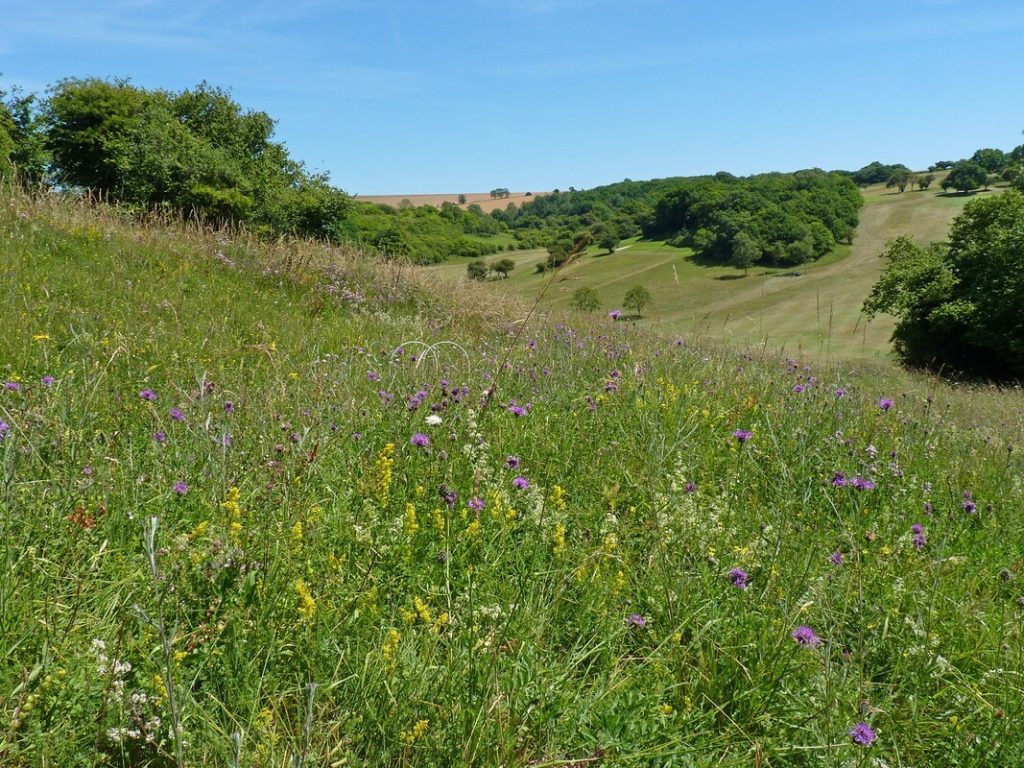Golf clubs across the South Downs National Park and beyond are coming together to help fight biodiversity loss. With golf courses covering two per cent of England and a significant number of clubs in the South Downs, there’s tremendous potential for courses to become havens for wildlife, particularly bees and butterflies, as well as golfers.
A network of golf clubs has now been formed, with greenkeepers and club managers from across the region coming together to share knowledge and practical support. Fourteen golf clubs from across Sussex recently took part in a seminar at Pyecombe Golf Club, near Brighton, which is now one of the best courses in the UK for chalk grassland flowers and butterflies.
It comes after the group’s inaugural meeting was held last year at Lewes Golf Club, which is also leading the way with biodiversity restoration on its course.The meetings have included live demonstrations on new grassland management techniques that can help wildlife, expert advice on conservation measures and details of funding available to clubs taking action for nature.
The initiative is being co-ordinated by Sussex-based charity, the Southwood Foundation, working with the South Downs National Park Authority and a range of partners, including RSPB, England Golf, the Weald to Waves initiative, Buglife and the South Downs Trust.
Over the last two years, South Downs Trust, has provided grants to Lewes Golf Club, East Brighton Golf Course and West Hove Golf Club to help with nature-friendly mowing equipment.

Pyecombe and Lewes have also been working with rangers from the South Downs National Park to develop a more wildlife-friendly mowing regime. Traditionally, grassy areas are mown and the cuttings are left on the ground to decompose, enriching the soil which then encourages coarser grasses to dominate and outcompete wildflowers. With the “cut and collect” system, the soil is not enriched with nutrients as the grass cuttings are collected.
Without the soil enrichment, the rare chalk grassland is maintained and a variety of wildflowers are able to grow and provide habitat for bees, butterflies and other insects.
Caroline Croft, Operations Manager for the Southwood Foundation, said: “There is an impressive number of golf clubs in Sussex doing really great work for nature recovery.
“We were struck that clubs were taking these nature restoration measures in relative isolation from each other and thought it could be useful to bring greenkeepers and club management together to share knowledge, ideas and best practice.
“Some of the clubs are at the beginning of the journey and others are further along such as Lewes, Pyecombe and Brighton and Hove Golf Club. All of them have been open and collaborative and there is a great sense of community and common purpose.
“Biodiversity in the UK is struggling, and we need nature corridors for wildlife to be able to thrive. I think there’s potential for golf clubs to play a significant role. . Their interest in being part of the 100-mile ‘Weald to Waves’ wildlife corridor through Sussex shows their enthusiasm. It’s inspiring to see these clubs working together to create excellent nature recovery projects.”
“Extending the roughs where possible is one really impactful step they can take. Clubs doing this are seeing significant increases in pollinators, such as butterflies without impeding the game, in fact enhancing the experience for players”.
Caroline Croft – Southwood Foundation
“It’s also about saving resources for clubs, working with nature to control pests instead of using expensive chemicals, for instance, being able to reduce water use, or spending less time and fuel on cutting back the roughs – so it’s a win-win for nature and people which makes it really exciting!
Caroline added: “The ownership of this sits very much within the golf sector – it’s greenkeepers seeing the potential and looking at what they can do.
“It’s been really rewarding working with a community that hasn’t always been part of nature conservation discussions, seeing what nature restoration means to them and the significant difference they can make.”
Tim Brewster, Course Manager at Lewes Golf Club, which received a grant from the South Downs National Park to buy a “cut and collect” machine, said: “After the first year, I have started to notice a larger amount of yellow rattle spreading to different areas of the course, which already looks to start thinning out the areas, which is great for golfers to find their ball but also a positive for wildflowers.
“The savings we have made are huge, we have cut down the time to complete this work to a month and a half. So that’s nearly cut the time in half, so saved lots of money on diesel and man hours.
“An increase of birds of prey has been noticed, with more kestrels, red kites, and buzzards. We continue to see the peregrine falcons that are nesting on the cliff, hunting, and playing on the fairways.”
Mandy Quick, Club Secretary of Lewes Golf Club, added: “We believe that by nurturing nature, we are making our golf course a more beautiful and enjoyable place for our members, visiting golfers and walkers. We also believe that we are helping to protect the environment for future generations.”
Last year an ecological survey at Pyecombe Golf Club discovered 34 species of butterfly, including rare species such as the adonis blue, brown hairstreak and grizzled skipper.
Jan Knowlson, Biodiversity Officer for the National Park, added: “Our ReNature campaign is tackling biodiversity loss head-on by creating new spaces for wildlife and also improving existing sites.
“The very nature of golf courses means that new habitat can be fairly easily created to support grassland species and Pyecombe and Lewes are proof that biodiversity and golfing can happily co-exist.
“It’s wonderful to see the golf community embracing nature recovery and I’m excited about what can be achieved in future.”
